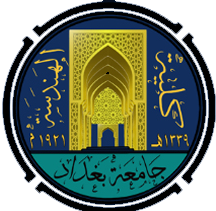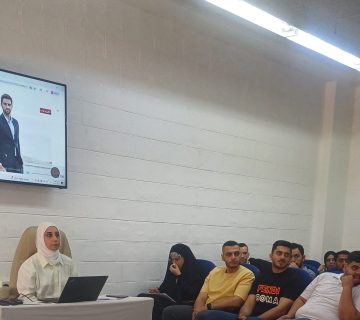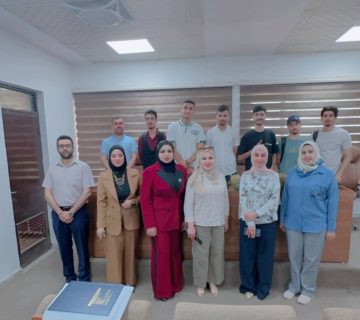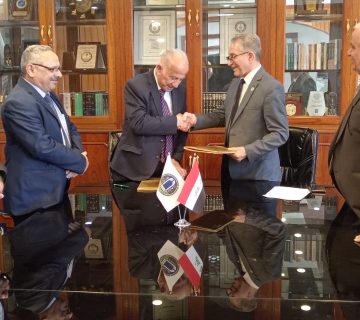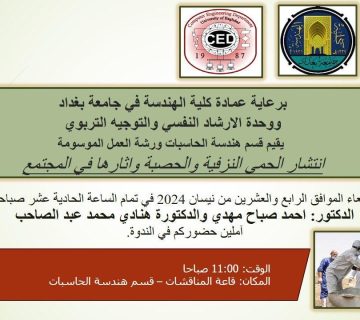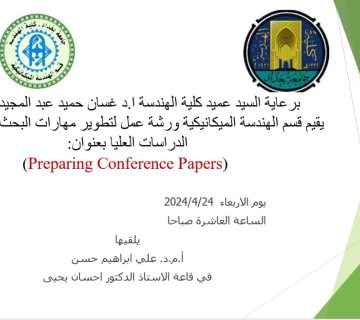تمت مناقشة رسالة الماجستير للطالبة: مروة محمد علي في قسم الهندسة المدنية /إختصاص هندسة صحية / جامعة بغداد
عن رسالتها الموسومة
(Treatment of Greywater using different Filtration Media)
(معالجة المياه الرمادية باستخدام وسائط ترشيح مختلفة)
يوم الأربعاء الموافق 2020/5/6 في قاعة الدكتور خالد شاكر وتألفت لجنة المناقشة من السادة المدرجة أسماءهم أدناه
الاستاذ المساعد الدكتورة اسرار عبد الله حسن … جامعة بغداد … رئيسًا
المدرس الدكتور حسين علي حميد … جامعة النهرين … عضوًا
الاستاذ المساعد الدكتورة سرى كريم علي … جامعة بغداد … عضوًا
الاستاذ المساعد الدكتورة نوار عمران علي … عضوًا ومشرفًا
المدرس الدكتور مهدي شنشل جعفر … عضوًا ومشرفًا
وقد نالت الطالبة درجة الماجستير في الهندسة المدنية
تناولت الدراسة إعادة استخدام المياه الرمادية كمصدر بديل او مساند للمياه من خلال إستخدام منظومة مختبرية لمعالجة مياه رمادية مصرفة بحجم 100 لتر،
وهذه العملية تتكون من عدة مراحل بدأً بالمعالجة الفيزيائية، التي تشمل الغربلة، لتخليص المياه الرمادية من الدقائق الصلبة الخشنة < 1.0 ملم، ثم التهوية، وأخيرا الترسيب بإستخدام خزان منفصل بحجم 100 لتر، ثم مرحلة الترشيح التي تتكون من ثلاثة مرشحات و ابعاد كل مرشح (أرتفاع 24 سم وقطر 9 سم) مرشح تصفية أحادية، ومرشح تصفية مزدوجة ومرشح رملي من أجل مقارنة كفائتهم به، تم إستخدام ثلاثة مجاميع كل واحدة مع وسائط ترشيح معينة تم أختيارها والتي هي صخور البورسلينايت المكسرة، والكربون الحبيبي المنشط، والزجاج المكسور المعاد تدويره، ولقد تبين أن التهوية الخارجية الاصطناعية لمدة ساعة واحدة يزيد تركيز الأوكسجين المذاب بدرجة مؤثرة، وهذا يعمل على خفض المتطلب الكيميائي للأوكسجين حوالي 20 ٪ -28 ٪ في بعض الحالات، في حين أن زيادة وقت تجهيز التهوية الخارجية لأكثر من 3.0 لم يؤدي الى تأثير ملموس
بينت النتائج الى أن استخدام المرشح المزدوج هو الأكثر فاعلية في خفض هذه الملوثات، بينما يشير المرشح الرملي إلى أدنى كفاءة إزالة. بشكل عام، كانت النتائج المستحصلة من أستخدام المرشح الكربوني هي الافضل في الاداء لتحسين جودة المياه الرمادية من حيث انخفاض المواد العضوية، لذلك يمكن استخدام المياه المُعالجة الناتجة في الاستخدامات العامة لتنظيف الشوارع و غيرها من الاستخدامات المختلفة ، والاستخدامات الصناعية، وكذلك الإستخدامات في المجال الزراعي كونه مقبول نسبيا من ناحية SAR التي كانت بحدود (1.35-1.34) عند مقارنته بالمواصفات العراقية للمياه المستخدمة للري. وفقا لذلك، قد تكون هذه التكنولوجيا موثوقة لمعالجة المياه الرمادية في منطقة سكنية. تم تسجيل أعلى كفاءة إزالة لمجموعة الزجاج المكسر المعاد تدويره في المرشح الرملي مع 2.0 ساعة للهواء الداخل ومعدل تدفق 50 مل / دقيقة, للمياه الرمادية الداخلة الى المرشح. حيث كانت النتائج 71 ٪ و 68 ٪ و 70٪ للعكارة، المتطلب الكيميائي للأوكسجين، والدهون على التوالي. وفي نفس هذه الظروف التجريبية، وجدت كفاءة أزالة وسائط المرشح المزدوج من الزجاج المعاد تدويره والرمل 66.7 ٪ ، 64.4 ٪ و 63.8 ٪ للعكارة ، والمتطلب الكيميائي للأوكسجين ، والدهون على التوالي.


 Abstract
Abstract
For many years until today, Iraq suffering from an urgent water crisis, and it is seriously affected by this, because there are no alternative sources of water corresponding with consumption. Particularly after recent environmental, and climatic changes, the water scarcity in water river, dams, and the shortage of rainfall with a time of increasing water demand through increased consumption. The agricultural sector is the most water consumer, therefore, attention going to the reuse of greywater as an alternative water resource. Greywater in this work, collect from bathrooms, washbasins, kitchen sink, and laundry, by that, the average production rate was found 161 L/c.d during the winter season and 181 L/c.d during the summer season, which reflects the reality of the situation in local area in the city of Baghdad.
This study presents the design of small scale greywater treatment, that is a combination of physical methods including screening of 1.0 mm, (aeration, sedimentation) using separate tank of about 100 L volume, and filtration system contains three filters of 24 cm in high and 9 cm in diameter for each (mono filter media, dual filter media and compares it with sand media) using three sets each set with one selected filter media which are Crushed Porcelanite Rock, Granular Activated Carbon, and Recycled Crushed Glass. Artificial aeration for more than 1.0 hr significantly increase Dissolved Oxygen concentration which enhances the reduction in COD about 20%-28% in some cases. Results from Natural Iraqi Material “Crushed Porcelanite Rocks” set was shown in expression of some greywater pollutants removal efficiency as Chemical Oxygen Demand 85.4%, Oil 86.8%, and Turbidity 84.6%, this highest removal efficiency was found in the dual media filter, and the duration of aeration was 2.0 hr with 50 mL/min influent flow rate. In Granular Activated Carbon set, removal efficiency of Turbidity 94.5%, Chemical Oxygen Demand 93.7%, and Oil 91.4% in the dual filter, while the duration of aeration was 2.0 hr with the flow rate influent to the filter is 50 mL/min, accordingly it was the most effective filter for decreasing these pollutants, while sand filter indicates the lowest removal efficiency in this set. In general, granular activated carbon media was the most proper media to improve greywater quality in terms of organic matter decrease, so its effluent can be used for municipal uses, industrial uses, and mainly for agricultural uses since it is acceptable to a certain extent compared with Iraqi standards for irrigation. Therefore, this technology may be reliable for greywater treatment in a residential area.
The maximum removal efficiency using Recycled Crushed Glass set was recorded in the Sand filter and the duration of aeration was 2.0 hr with the flow rate influent to the filter of 50 mL/min. which is 71.4%, 68.5% and 70.6% for Turbidity, Chemical Oxygen Demand, and oil respectively. In the same condition, dual filter of Recycled Crushed Glass and sand media removal efficiency was 66.7%, 64.4% and 63.8% for Turbidity, Chemical Oxygen Demand, and oil respectively.

